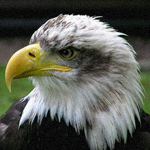There are 27 birds of prey in Quebec, all of which are protected by provincial law:
- Osprey
- Bald Eagle
- Northern Harrier
- Sharp-shinned Hawk
- Cooper's Hawk
- Northern Goshawk
- Golden Eagle
- Red-shouldered Hawk
- Broad-winged Hawk
- Red-tailed Hawk
- Rough-legged Hawk
- American Kestrel
- Peregrine
- Merlin
- Falcon
- Gyrfalcon
- Eastern Screech-Owl
- Great Horned Owl
- Snowy Owl
- Northern Hawk Owl
- Barred Owl
- Long-eared Owl
- Short-eared Owl
- Boreal Owl
- Northern Saw-whet Owl
- Great Grey Owl (Rare visitor)
- Turkey Vulture (Range moving North)
- It is illegal to hunt or own a raptor without a permit.
- Obviously, not all of them inhabit suburban areas. Most inhabit deep boreal or deciduous forests and stay well away from urban centres. Those that are most likely to be seen in suburban (and sometimes urban) areas are: American Kestrel, Sharp-shinned Hawk, Peregrine Falcon, Merlin, Cooper's Hawk and Red-tailed Hawk.
- If a bird of prey is attacking the birds in your backyard, other than a complete and permanent halt in the feeding (and thus not attracting them to their deaths), there is not much to be done. Let nature takes its course and enjoy the educational opportunity. A temporary halt is not effective since the raptor will return the moment the seedeaters do. In addition, if you stop feeding the smaller birds, the raptor will simply go to another feeder.
- The seedeaters that they mainly feed on have high reproductive rates and so can tolerate a high mortality rate without being adversely affected.
- Try hanging mylar strips that can flap in the wind or aluminium pie plates: this may deter the raptors from entering your backyard.
- In addition, give your passerines an edge: place the feeder about 6-10 metres away from dense cover (an evergreen, bushes, etc.). This will let them escape if they sense danger, but keep other potential ground predators at bay.
- Most of the birds that live around here are fairly small and cannot take much more than a pigeon-sized bird. They prefer plucking birds straight out of the air. They prefer birds to mammals and cannot usually eat cats.
- Great-horned owls have been known to eat quite large prey.
- Peregrine falcons: One of the most widely distributed birds in the world (with ospreys and ravens). Though almost extinct in certain areas, these birds have made a remarkable comeback in recent years. They tend to prefer pigeons and other small wild birds. They usually nest on cliffs or hollowed out trees: they do not tend to build their own nests and change nest sites from year to year (either to keep bacteria at bay or to fool potential predators). They scrape out shallow hollows in whatever surface they choose to lay their eggs in so that their eggs do not roll out of the nest. There are usually 3-4 eggs per nest, covered by red-brown markings. One egg is generally laid every two days until the clutch is complete. These eggs are then incubated for about 28-29 days. The young can fly 35-42 days after hatching. Peregrines have the ability to lay a second clutch of eggs if the first set is destroyed early in incubation.

